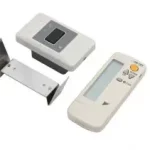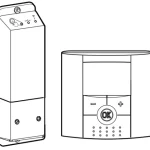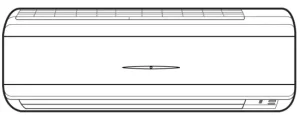
 DAIKIN ROOM AIR CONDITIONER
DAIKIN ROOM AIR CONDITIONER
Operation Manual

| MODELS | FT13BV1LS |
| FT18BV1LS | |
| FT24BV1LS |

Safety precautions
- Keep this manual where the operator can easily find them.
- Read this manual attentively before starting up the unit.
- For safety reasons, the operator must read the following cautions carefully.
- This manual classifies precautions into WARNINGS and CAUTIONS. Be sure to follow all precautions below: they are all important for ensuring safety.
![]() WARNING
WARNING
If you do not follow these instructions exactly, the unit may cause property damage, personal injury, or loss of life.
![]() CAUTION
CAUTION
If you do not follow these instructions exactly, the unit may cause minor or moderate property damage or personal injury.
![]() Never do.
Never do.
![]() Be sure to earth the air conditioner.
Be sure to earth the air conditioner.
![]() Never touch the air conditioner (including the remote controller) with a wet hand.
Never touch the air conditioner (including the remote controller) with a wet hand.
![]() Be sure to follow the instructions.
Be sure to follow the instructions.
![]() Never cause the air conditioner (including the remote controller) to get wet.
Never cause the air conditioner (including the remote controller) to get wet.
![]() WARNING
WARNING
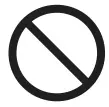 In order to avoid fire, explosion or injury, do not operate the unit when harmful, among which flammable or corrosive gases, are detected near the unit.
In order to avoid fire, explosion or injury, do not operate the unit when harmful, among which flammable or corrosive gases, are detected near the unit.- It is not good for your health to expose your body to airflow for a long time.
- Do not put a finger, a rod, or other objects into the air outlet or inlet. As the fan is rotating at a high speed, it will cause injury.
- Do not attempt to repair, relocate, modify or reinstall the air conditioner by yourself. Incorrect work will cause electric shocks, fire, etc.
For repairs and reinstallation, consult your Daikin dealer for advice and information.  The refrigerant used in the air conditioner is safe. Although leaks should not occur, if for some reason any refrigerant happens to leak into the room, make sure it does not come in contact with any flame as of gas heaters, kerosene heaters, or gas range.
The refrigerant used in the air conditioner is safe. Although leaks should not occur, if for some reason any refrigerant happens to leak into the room, make sure it does not come in contact with any flame as of gas heaters, kerosene heaters, or gas range.- If the air conditioner is not cooling properly, the refrigerant may be leaking, so call your dealer.
When carrying out repairs accompanying adding refrigerant, check the content of the repairs with our service staff. - Do not attempt to install the air conditioner by yourself. Incorrect work will result in water leakage, electric shocks, or fire. For installation, consult the dealer or a qualified technician.
- In order to avoid electric shock, fire, or injury, if you detect any abnormality such as the smell of fire, stop the operation and turn off the breaker. And call your dealer for instructions.
- Depending on the environment, an earth leakage breaker must be installed. The lack of an earth leakage breaker may result in electric shocks or fire.
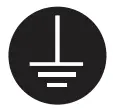 The air conditioner must be earthed. Incomplete earthing may result in electric shocks. Do not connect the earth line to a gas pipe, water pipe, lightning rod, or telephone earth line.
The air conditioner must be earthed. Incomplete earthing may result in electric shocks. Do not connect the earth line to a gas pipe, water pipe, lightning rod, or telephone earth line.
![]() CAUTION
CAUTION
 In order to avoid any quality deterioration, do not use the unit for cooling precision instruments, food, plants, animals, or works of art.
In order to avoid any quality deterioration, do not use the unit for cooling precision instruments, food, plants, animals, or works of art.- Never expose little children, plants, or animals directly to the airflow.
- Do not place appliances that produce open fire in places exposed to the airflow from the unit or under the indoor unit. It may cause incomplete combustion or deformation of the unit due to the heat.
- Do not block air inlets or outlets. Impaired airflow may result in insufficient performance or trouble.
- Do not stand or sit on the outdoor unit. Do not place any object on the unit to avoid injury, do not remove the fan guard.
- Do not place anything under the indoor or outdoor unit that must be kept away from moisture. In certain conditions, moisture in the air may condense and drip.
- After long use, check the unit stand and fittings for damage.
- Do not touch the air inlet and aluminum fins of the outdoor unit. It may cause injury.
- The appliance is not intended for use by young children or infirm persons without supervision.
- Young children should be supervised to ensure that they do not play with the appliance.
 To avoid oxygen deficiency, ventilate the room sufficiently if equipment with a burner is used together with the air conditioner.
To avoid oxygen deficiency, ventilate the room sufficiently if equipment with a burner is used together with the air conditioner.- Before cleaning, be sure to stop the operation, turn the breaker off or pull out the supply cord.
- Do not connect the air conditioner to a power supply different from the one specified. It may cause trouble or fire.
- Arrange the drain hose to ensure smooth drainage. Incomplete draining may cause wetting of the building, furniture, etc.
- Do not place objects in direct proximity of the outdoor unit and do not let leaves and other debris accumulate around the unit.
Leaves are a hotbed for small animals which can enter the unit. Once in the unit, such animals can cause malfunctions, smoke, or fire when making contact with electrical
parts.  Do not operate the air conditioner with wet hands.
Do not operate the air conditioner with wet hands.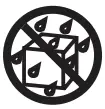 Do not wash the indoor unit with excessive water, only use a slightly wet cloth.
Do not wash the indoor unit with excessive water, only use a slightly wet cloth.- Do not place things such as vessels containing water or anything else on top of the unit. Water may penetrate into the unit and degrade electrical insulations, resulting in an electric shock.
Installation site
To install the air conditioner in the following types of environments, consult the dealer.
- Places with an oily ambient or where steam or soot occurs.
- Salty environment such as coastal areas.
- Places where sulfide gas occurs such as hot springs.
- Places where snow may block the outdoor unit.
The drain from the outdoor unit must be discharged to a place of good drainage.
Consider nuisance to your neighbors from noises
For installation, choose a place as described below.
- A place solid enough to bear the weight of the unit which does not amplify the operation noise or vibration.
- A place from where the air discharged from the outdoor unit or the operation noise will not annoy your neighbors.
Electrical work
- For power supply, be sure to use a separate power circuit dedicated to the air conditioner.
System relocation
- Relocating the air conditioner requires specialized knowledge and skills. Please consult the dealer if the relocation is necessary for moving or remodeling
Names of parts
Indoor Unit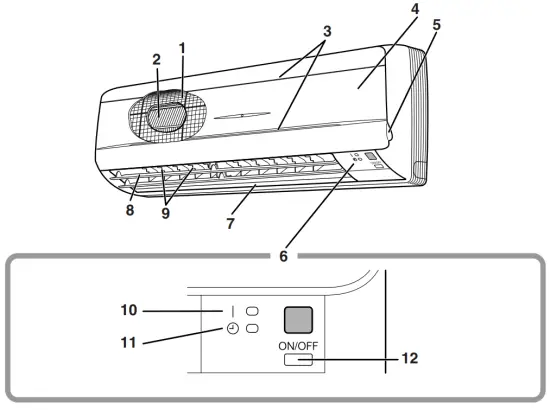
Main unit control panel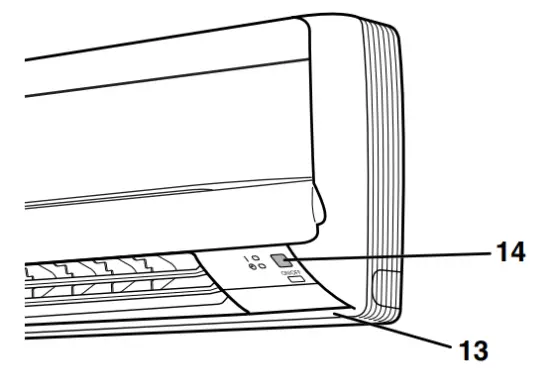
Outdoor Unit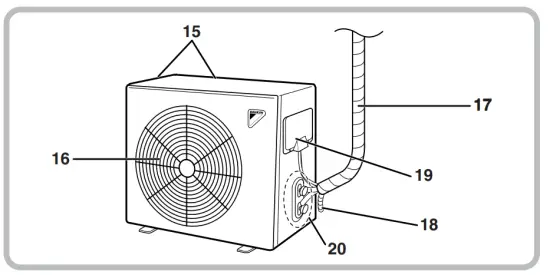
Indoor Unit
- Air filter
- Air purifying filter with photocatalytic deodorizing function:
• These filters are attached to the inside of the air filters. - Air inlet
- Front grille
- Grille tab
- Display
- Air outlet
- Flaps (horizontal blades): (page 12.)
- Louvers (vertical blades):
• The louvers are inside the air outlet. (page 12, 13.) - Operation lamp (green)
- TIMER lamp (yellow): (page 15.)
- Indoor Unit ON/OFF switch:
• Push this switch once to start operation. Push once again to stop it.
• The operation mode refers to the following table.Mode Temperature setting Airflow rate COOL 22°C AUTO • This switch is useful when the remote controller is missing.
- Room temperature sensor:
• It senses the air temperature around the unit. - Signal receiver:
• It receives signals from the remote controller.
• When the unit receives a signal, you will hear a short beep.
• Operation start ………….beep-beep
• Settings changed……….beep
• Operation stop …………..beeeeep
Outdoor Unit - Air inlet: (Back and side)
- Air outlet
- Refrigerant piping and inter-unit cable
- Drain hose
- Earth terminal:
• It is inside of this cover. - Stop valve:
• Dew condensation may form on the stop valve during operation. This does not indicate any type of malfunction in the outdoor unit.
Remote Controller

- Signal transmitter:
• It sends signals to the indoor unit. - Display:
• It displays the current settings.
(In this illustration, each section is shown with all its displays ON for the purpose of explanation.) - POWERFUL button:
for POWERFUL operation (page 14.) - TEMPERATURE adjustment buttons:
• It changes the temperature setting. - ON/OFF button:
• Press this button once to start operation.
Press once again to stop it. - MODE selector button:
• It selects the operation mode. (DRY/COOL/FAN) (page 10.) - FAN setting button:
• It selects the airflow rate setting. - SWING button: (page 12.)
• Flap (Horizontal blade) - SWING button: (page 12.) (18, 24 class only)
• Louver (Vertical blades) - ON TIMER button: (page 16.)
- OFF TIMER button: (page 15.)
- TIMER Setting button:
• It changes the time setting. - TIMER CANCEL button:
• It cancels the timer setting. - CLOCK button: (page 9.)
Preparation Before Operation
To set the batteries
- Press
 with a finger and slide the front cover to take it off.
with a finger and slide the front cover to take it off. - Set two dry batteries (AAA).
- Set the front cover as before.
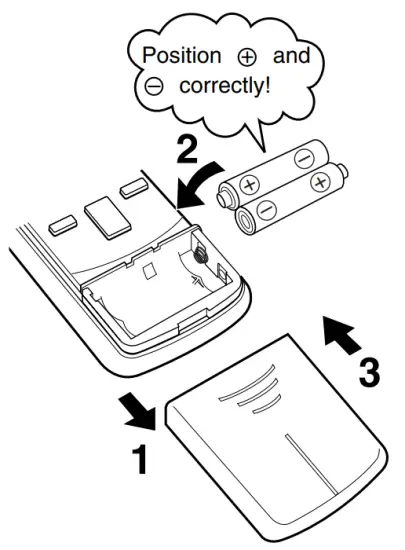
ATTENTION
About batteries
- When replacing the batteries, use batteries of the same type, and replace the two old batteries together.
- When the system is not used for a long time, take the batteries out.
- We recommend replacing once a year, although if the remote controller display begins to fade or if reception deteriorates, please replace it with new alkali batteries. Using manganese batteries reduces the lifespan.
- The attached batteries are provided for the initial use of the system.
The usable period of the batteries may be short depending on the manufactured date of the air conditioner.
Preparation Before Operation
To operate the remote controller
- To use the remote controller, aim the transmitter at the indoor unit. If there is anything to block signals between the unit and the remote controller, such as a curtain, the unit will not operate.
- Do not drop the remote controller. Do not get it wet.
- The maximum distance for communication is about 7 m.
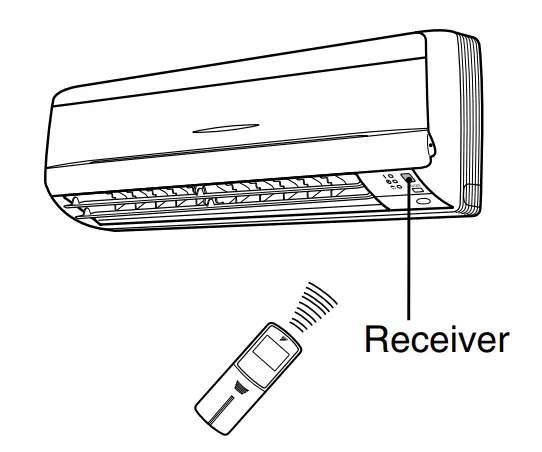
To fix the remote controller holder on the wall
- Choose a place from where the signals reach the unit.
- Fix the holder to a wall, a pillar, etc.
with the screws supplied with the holder. - Place the remote controller in the remote controller holder.

ATTENTION
About remote controller
- Never expose the remote controller to direct sunlight.
- Dust on the signal transmitter or receiver will reduce the sensitivity. Wipe off dust with a soft cloth.
- Signal communication may be disabled if an electronic-starter-type fluorescent lamp (such as inverter-type lamps) is in the room. Consult the shop if that is the case.
- If the remote controller signals happen to operate another appliance, move that appliance to somewhere else, or consult the shop.
To set the clock
- Press the “CLOCK button”.
 is displayed.
is displayed.
 blinks.
blinks. - Press the “TIMER setting button” to set the clock to the present time.
Holding down “ ” or “
” or “ button rap-
button rap-
idly increases or decreases the time display. - Press the “CLOCK button”.
blinks.
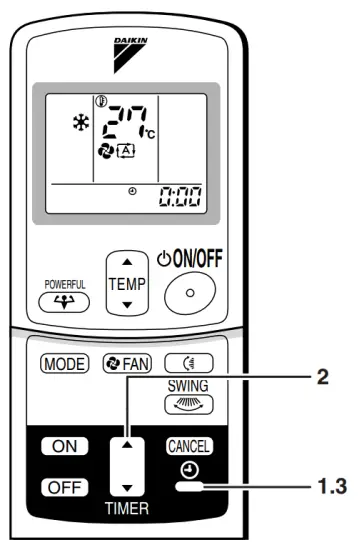
Turn the breaker ON
- Turning ON the breaker opens the flap, then closes it again. (This is a normal procedure.)
NOTE
Tips for saving energy
- Be careful not to cool the room too much.
Keeping the temperature setting at a moderate level helps save energy. - Cover windows with a blind or a curtain.
Blocking sunlight and air from outdoors increases the cooling effect. - Clogged air filters cause inefficient operation and waste energy. Clean them once about every two weeks.
| Recommended temperature setting |
| For cooling:26°C – 28°C |
Please note
- The air conditioner always consumes 15-35 watts of electricity even while it is not operating.
- If you are not going to use the air conditioner for a long period, for example in spring or autumn, turn the breaker OFF.
- Use the air conditioner in the following conditions.
Mode Operating conditions If the operation is continued out of this range COOL Outdoor temperature: 20 to 46 °C
Indoor temperature: 18 to 32 °C
Indoor humidity: 80% max.• A safety device may work to stop the operation. DRY Outdoor temperature: 20 to 46 °C
Indoor temperature: 18 to 32 °C
Indoor humidity: 80% max.• A safety device may work to stop the operation.
• Condensation may occur on the indoor unit and drip. - Operation outside this humidity or temperature range may cause a safety device to disable the system.
DRY · COOL · FAN Operation
The air conditioner operates with the operation mode of your choice.
From the next time on, the air conditioner will operate with the same operation mode.
To start operation
- Press the “MODE selector button” and select an operation mode.
• Each pressing of the button advances the mode setting in sequence.
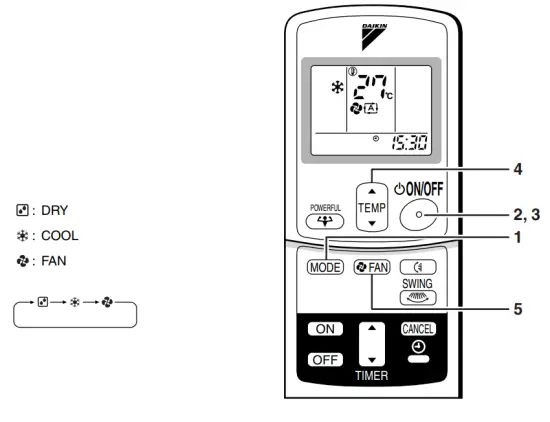
- Press the “ON/OFF button”.
• The OPERATION lamp lights up.
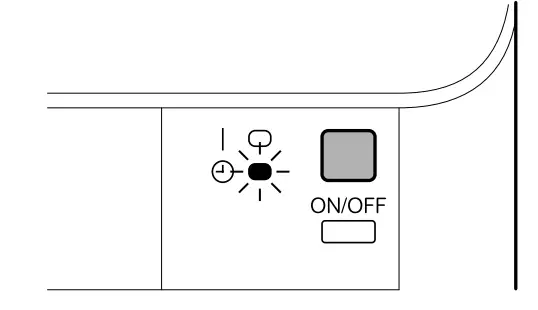 To stop operation
To stop operation - Press the “ON/OFF button” again.
• Then the OPERATION lamp goes off.
To change the temperature setting - Press the “TEMPERATURE adjustment button”
DRY or FAN mode COOL mode The temperature setting is not variable. Press “  ” to raise the temperature and press “
” to raise the temperature and press “ ” to lower the temperature.
” to lower the temperature.Set to the temperature you like. 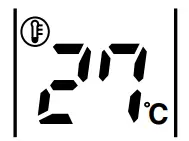
To change the airflow rate setting
- Press the “FAN setting button”.
DRY mode COOL or FAN mode The air flow rate setting is not variable. Five levels of air flow rate setting from  plus “
plus “ ” are available.
” are available.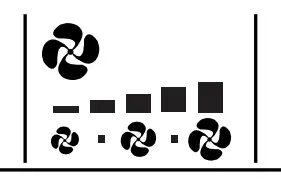
To change the airflow direction
(page 12.)
NOTE
- Note on the DRY operation
• The computer chip works to rid the room of humidity while maintaining the temperature as much as possible. It automatically controls temperature and fan strength, so manual adjustment of these functions is unavailable. - Note on airflow rate setting
• At smaller airflow rates, the cooling effect is also smaller.
Adjusting the Air Flow Direction
You can adjust the airflow direction to increase your comfort.
To adjust the horizontal blades (flaps)
- Press the “SWING button”.
 The display will light up and the flaps will begin to swing.
The display will light up and the flaps will begin to swing. - When the flaps have reached the desired position, press the “SWING button” once more.
The display will go blank.
The flaps will stop moving.
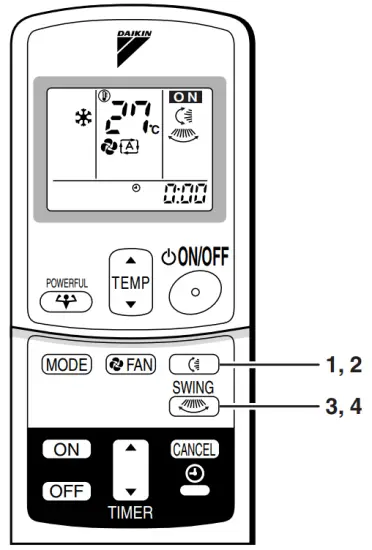 To adjust the vertical blades (louvers) (18, 24 class only)
To adjust the vertical blades (louvers) (18, 24 class only) - Press the “SWING button”.
 The display will light up and the louvers will begin to swing.
The display will light up and the louvers will begin to swing. - When the louvers have reached the desired position, press the “SWING” button once more.
The display will go blank.
The louvers will stop moving.
To 3-D Airflow (18, 24 class only)
1. 3. press the “SWING button”: the “ ![]() ” “
” “ ![]() ” display will light up and the flaps and louvers will move in turn.
” display will light up and the flaps and louvers will move in turn.
To cancel 3-D Airflow (18, 24 class only)
2. 4. press the “SWING button”
To adjust the vertical blades (louvers) (13 class only)
Hold the knob and move the louvers.
(You will find a knob on the left-side and the right-side blades.)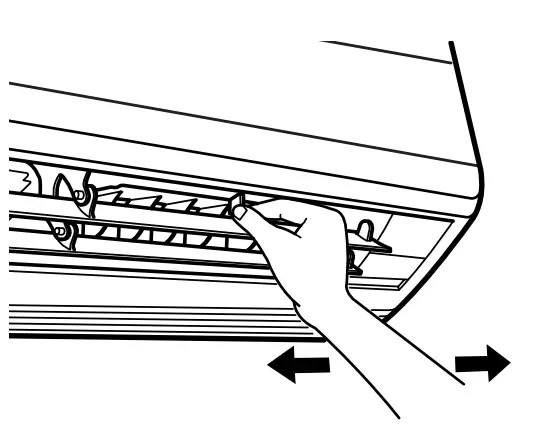 Notes on louvers angles
Notes on louvers angles
ATTENTION
- Always use a remote controller to adjust the louver’s angles. Inside the air outlet, a fan is rotating at a high speed. (18, 24 class only)
- Be careful when adjusting the louvers. Inside the air outlet, the fan is rotating at a high speed. (13 class only)
Notes on flap angle
- When the “SWING button” is selected, the flap swinging range depends on the operation mode. (See the figure.)
Three-Dimensional (3-D) Airflow
- Using three-dimensional airflow circulates cold air, which tends to collect at the bottom of the room, and hot air, which tends to collect near the ceiling, throughout the room, preventing areas of cold and hot from developing.

ATTENTION
- Always use a remote controller to adjust the flaps angle.
If you attempt to move it forcibly with your hand when it is swinging, the mechanism may be broken.
POWERFUL Operation
The POWERFUL operation quickly maximizes the cooling (heating) effect in any operation mode. You can get the maximum capacity.
1. Press the “POWERFUL button”.
- POWERFUL operation ends in 20 minutes.
Then the system automatically operates again with the settings which were used before POWERFUL operation. - When using POWERFUL operation, there are some functions that are not available.
 To cancel the POWERFUL operation
To cancel the POWERFUL operation
2. Press the “POWERFUL button” again.
NOTE
Notes on POWERFUL operation
- In COOL mode
To maximize the cooling effect, the capacity of the outdoor unit must be increased and the air flow rate is fixed to the maximum setting.
The temperature and airflow settings are not variable. - In DRY mode
The temperature setting is lowered by 2.5°C and the airflow rate is slightly increased. - In FAN mode
The airflow rate is fixed to the maximum setting.
TIMER Operation
Timer functions are useful for automatically switching the air conditioner on or off at night or in the morning. You can also use OFF TIMER and ON TIMER in combination.
To use OFF TIMER operation
• Check that the clock is correct.
If not, set the clock to the present time.
(page 9.)
- Press “OFF TIMER button”.
 is displayed.
is displayed.
 blinks.
blinks. - Press the “TIMER Setting button” until the time setting reaches the point you like.
• Every pressing of either button increases or decreases the time setting by 10 minutes. Holding down either button change the setting rapidly.
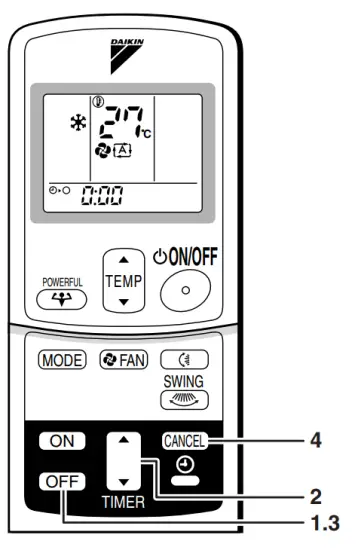
- Press the “OFF TIMER button” again.
• The TIMER lamp lights up.
 To cancel the OFF TIMER operation
To cancel the OFF TIMER operation - Press the “CANCEL button”.
• The TIMER lamp goes off.
Notes
- When TIMER is set, the present time is not displayed.
- Once you set ON, OFF TIMER, the time setting is kept in the memory. (The memory is canceled when remote controller batteries are replaced.)
- When operating the unit via the ON/OFF Timer, the actual length of operation may vary from the time entered by the user. (Maximum approx. 10 minutes)
NIGHT SET MODE
When the OFF TIMER is set, the air conditioner automatically adjusts the temperature setting (0.5°C up in COOL) to prevent excessive cooling for your pleasant sleep.
To use ON TIMER operation
• Check that the clock is correct. If not, set the clock to the present time (page 9.).
- Press the “ON TIMER button”.
 is displayed.
is displayed.
 blinks.
blinks. - Press the “TIMER Setting button” until the time setting reaches the point you like.
• Every pressing of either button increases or decreases the time setting by 10 minutes. Holding down either button changes the setting rapidly.
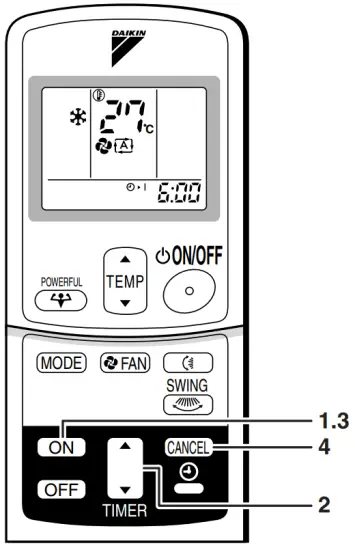
- Press the “ON TIMER button” again.
• The TIMER lamp lights up.
 To cancel ON TIMER operation
To cancel ON TIMER operation - Press the “CANCEL button”.
• The TIMER lamp goes off.
To combine ON TIMER and OFF TIMER
- A sample setting for combining the two timers is shown below.

ATTENTION
In the following cases, set the timer again.
- After a breaker has turned OFF.
- After a power failure.
- After replacing batteries in the remote controller.
Care and Cleaning
![]() CAUTION
CAUTION
Before cleaning, be sure to stop the operation and turn the breaker OFF.
Units
Indoor unit, Outdoor unit, and Remote controller
- Wipe them with a dry soft cloth.
Front grille
- Open the front grille.
• Hold the grille by the tabs on the two sides and lift it until it stops with a click.
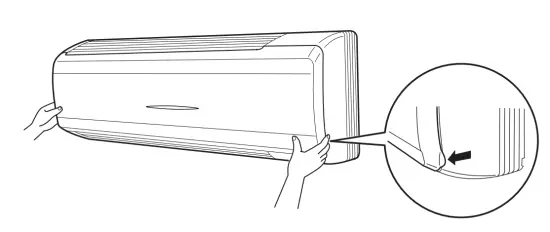
- Remove the front grille.
• Open the front panel further while sliding it to either the left or right and pulling it toward you. This will disconnect the rotation dowel on one side. Then disconnect the rotation dowel on the other side in the same manner.
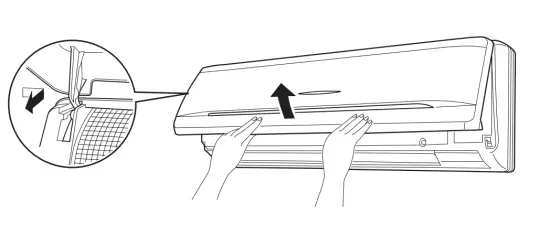
- Clean the front grille
• Wipe it with a soft cloth soaked in water.
• Only neutral detergent may be used.
• In case of washing the grille with water, dry it with a cloth and dry it up in the shade after washing. - Attach the front grille
• Align the rotation dowels on the left and right of the front panel with the slots, then push them all the way in.
• Close the front panel slowly. (Press the panel at both sides and the center.)
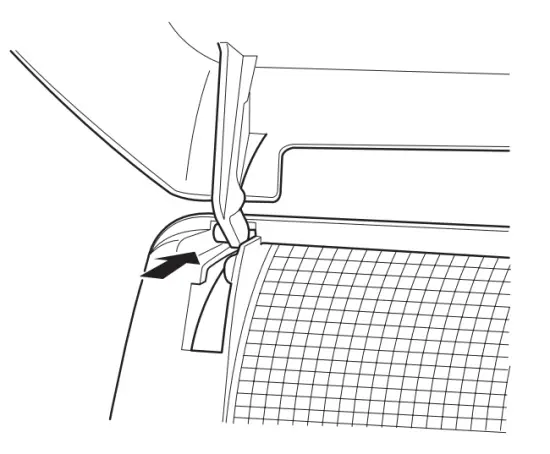
![]() CAUTION
CAUTION
- Don’t touch the metal parts of the indoor unit. If you touch those parts, this may cause an injury.
- When removing or attaching the front grille, use a robust and stable stool and watch your steps carefully.
- When removing or attaching the front grille, support the grille securely with your hand to prevent it from falling.
- For cleaning, do not use hot water above 40 °C, benzine, gasoline, thinner, other volatile oils, polishing compounds, scrubbing brushes, or other hand stuff.
- After cleaning, make sure that the front grille is securely fixed.
Filters
- Open the front grille. (page 17.)
- Pull out the air filters.
• Push a little upwards the tab at the center of each air filter, then pull it down.
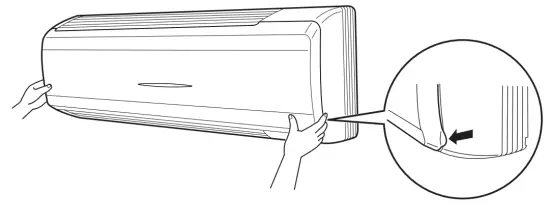
- Take off the air purifying filter with a photocatalytic deodorizing function.
• Press the top of the air-cleaning filter onto the tabs (3 tabs at the top). Then press the bottom of the filter up slightly, and press it onto the tabs (3 at the bottom).
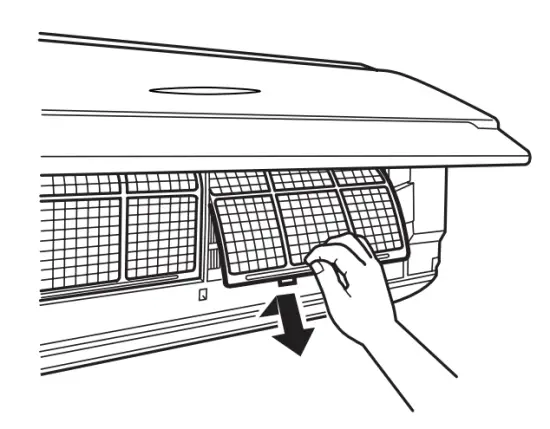
- Clean or replace each filter.
See figure.
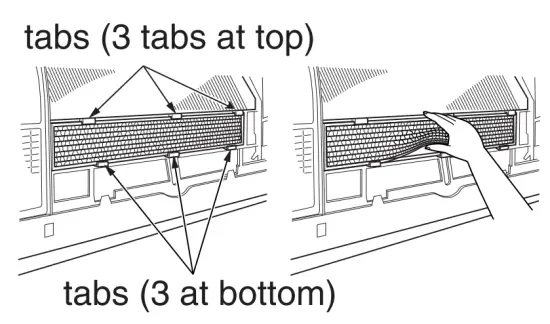
- Set the air filter, air-purifying filter with photocatalytic deodorizing function as they were, and close the front grille.
• Press the front panel on both sides and the center.
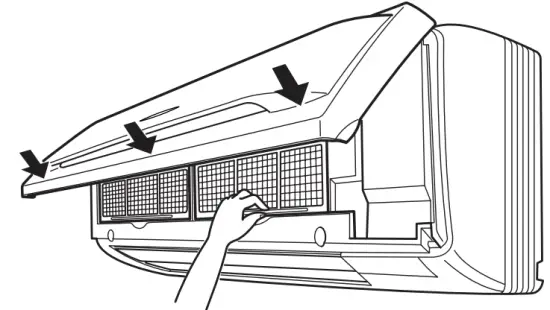
Air Filter
- Wash the air filters with water or clean them with a vacuum cleaner.
• If the dust does not come off easily, wash them with neutral detergent thinned with lukewarm water, then dry them up in the shade.
• It is recommended to clean the air filters every two weeks.
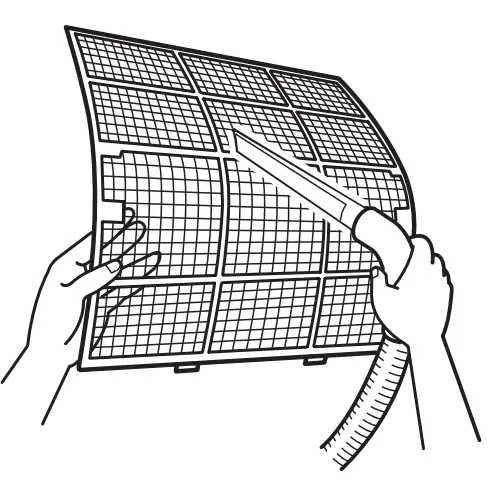
Air purifying filter with photocatalytic deodorizing function. (gray)
The air purifying capacity of the photocatalytic purifying filter can be renewed by washing it with
water once every 6 months. We recommend replacing it once every 3 years.
[ Maintenance ]
- Remove dust with a vacuum cleaner and wash lightly with water.
- If it is very dirty, soak it for 10 to 15 minutes in water mixed with a neutral cleaning agent.
- After washing, shake off the remaining water and dry in the shade
- Since the material is made out of paper, do not wring out the filter when removing water from it.
[ Replacement]
- Remove the tabs on the filter frame and replace them with a new filter.
• Dispose of the old filter as flammable waste.
Check
- Check that the base, stand and other fittings of the outdoor unit are not decayed or corroded.
- Check that nothing blocks the air inlets and the outlets of the indoor unit and the outdoor unit.
- Check that the earth wire is not disconnected or broken.
- Check that the drain comes smoothly out of the drain hose during COOL or DRY operation.
•If no drain water is seen, water may be leaking from the indoor unit. Stop operation and consult the service shop if this is the case.
Before a long idle period
- Operate the “fan-only” for several hours on a fine day to dry out the inside.
• Press the “MODE” button and select the “fan” operation.
• Press the “ON/OFF” button and start operation. - Clean the air filters and set them again.
- Take out batteries from the remote controller.
- Turn OFF the breaker for the room air conditioner.
NOTE
- Operation with dirty filters:
(1) cannot deodorize the air.
(2) cannot clean the air.
(3) results in poor heating or cooling.
(4) may cause odor. - To order an air-purifying filter with a photocatalytic deodorizing function contact the service shop where you bought the air conditioner.
- Dispose of the old air filters as non-burnable and photocatalytic deodorizing filters as burnable waste.
| Item | Part No. |
| Air purifying filter with photocatalytic deodorizing function. (without frame) 1 set | KAF952A42 |
Trouble Shooting
These cases are not trouble.
The following cases are not air conditioner troubles but have some reasons. You may just continue using it.
| Case | Explanation |
The operation does not start soon.
|
|
| The outdoor unit emits water or steam. | In COOL or DRY mode
|
| Mists come out of the indoor unit. | This happens when the air in the room is cooled into mist by the cold airflow during the cooling operation. |
| The indoor unit gives out an odor. | This happens when smells of the room, furniture, or cigarettes are absorbed into the unit and discharged with the airflow. (If this happens, we recommend you to have the indoor unit washed by a technician. Consult the service shop where you bought the air conditioner.) |
| The outdoor fan rotates while the air conditioner is not in operation. | After the operation is stopped:
|
| The operation stopped suddenly. (OPERATION lamp is on) |
For system protection, the air conditioner may stop operating on a sudden large voltage fluctuation. It automatically resumes operation in about 3 minutes. |
Check again.
Please check again before calling a repair person.
| Case | Check |
| The air conditioner does not operate. (OPERATION lamp is off) |
|
| The cooling effect is poor. |
|
| Operation stops suddenly. (OPERATION lamp flashes.) |
Clean the air filters or take all obstacles away and turn the breaker OFF. Then turn it ON again and try operating the air conditioner with the remote controller. If the lamp still flashes, call the service shop where you bought the air conditioner. |
| An abnormal functioning happens during an operation. |
|
Call the service shop immediately.
![]() WARNING
WARNING
- When an abnormality (such as a burning smell) occurs, stop operation and turn the breaker OFF.
Continued operation in an abnormal condition may result in troubles, electric shocks, or fire.
Consult the service shop where you bought the air conditioner. - Do not attempt to repair or modify the air conditioner by yourself.
Incorrect work may result in electric shocks or fire.
Consult the service shop where you bought the air conditioner.
If one of the following symptoms takes place, call the service shop immediately.
|
Turn the breaker OFF and call the service shop. |
|
|
We recommend periodical maintenance
In certain operating conditions, the inside of the air conditioner may get foul after several seasons of use, resulting in poor performance. It is recommended to have periodical maintenance by a specialist aside from regular cleaning by the user. For specialist maintenance, contact the service shop where you bought the air conditioner.
The maintenance cost must be borne by the user.
Specification
| INDOOR UNIT | FT13BV1LS | FT18BV1LS | FT24BV1LS | ||
| OUTDOOR UNIT | R13BV1LS | R18BV1LS | R24BV1LS | ||
| COOLING CAPACITY | kW | 4.1 | 5.2 | 6.6 | |
| RUNNING CURRENT | A | 5.5 | 7.2 | 11.0 | |
| POWER CONSUMPTION | W | 1180 | 1560 | 2340 | |
| INDOOR UNIT | DIMENSION | H (mm) | 290 | 290 | 290 |
| W (mm) | 1050 | 1050 | 1050 | ||
| D (mm) | 238 | 238 | 238 | ||
| NET WEIGHT | kg | 12 | 12 | 12 | |
| OUTDOOR UNIT | DIMENSION | H (mm) | 540 | 685 | 685 |
| W (mm) | 750 | 800 | 800 | ||
| D (mm) | 270 | 300 | 300 | ||
| NET WEIGHT | kg | 37 | 49 | 61 | |
| Notes: Cooling capacities and electric characteristics are based on 27°C DB, 19°C WB indoor temp, and 35°C DB outdoor temp, at Hi fan speed and 220V, 50Hz. | |||||
 SIAM DAIKIN SALES CO.LTD.
SIAM DAIKIN SALES CO.LTD.
22 Soi Onnuch 55/1 On-nuch Rd., Pravet
Subdistrict, Pravet District, Bangkok 10250
Thailand.
Tel : 0-2721-7670-84
Fax : 0-2721-7607-8
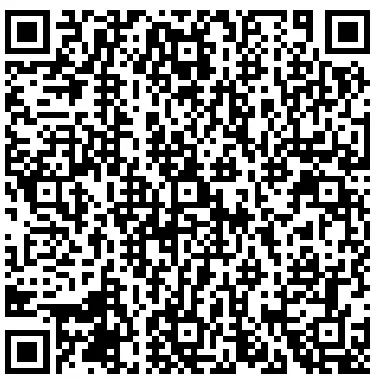 00_CV_3P098595-10R.pdf 2007/3/8/17:54
00_CV_3P098595-10R.pdf 2007/3/8/17:54
01_EN_3P098595-10R.pdf 2007/3/17/16:24
02_TH_3P098595-10R.pdf 2007/03/26/17:17
A two-dimensional bar code is a code for manufacturing.
3P098595-10R
M02B111D
(0703)
HT
